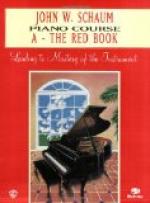“In regard to methods in piano study my principles are based wholly upon my observations of Leschetizky’s work with me personally, or with others. What I know he has taught me; what I have achieved I owe to him. My first eight weeks in Vienna were spent in learning, first, to control position and condition of hands and arms according to the law of balance; secondly, to direct each motion with the utmost accuracy and speed. To accomplish this I began with the most elementary exercises in five-finger position, using one finger at a time. Then came the principles of the scale, arpeggios, chords and octaves. All these things were continued until every principle was mastered. I practised at first an hour a day, then increased the amount as my hands grew stronger and the number of exercises increased.
“Next came the study of tone production in various forms, a good quality invariably being the result of a free condition of the arm combined with strength of fingers and hands.
“The Leschetizky principles seem to me the most perfect and correct in every particular. Yes, there are several books of the method, by different authors, but I teach the principles without a book. The principles themselves are the essential things. I aim to build up the hand, to make it strong and dependable in every part, to fill out the weak places and equalize it. That this may be thoroughly and successfully accomplished, I require that nothing but technical exercises be used for the first nine, ten, or twelve weeks. We begin with the simplest exercises, one finger at a time, then two, three and so on through the hand. I believe in thus devoting all the practise time to technic, for a certain period, so that the mind is free to master the principles, undisturbed by piece playing. When the principles have been assimilated, the attention can then be directed to the study of music itself. If any weak places appear in the hand from time to time, they can be easily corrected.
“If a pupil comes to me who has played a great deal but with no idea of the principles of piano playing, who does not know how to handle herself or the keyboard, it is absolutely necessary to stop everything and get ready to play. If you attempt even a simple sonata with no legato touch, no idea of chord or scale playing, you can not make the piece sound like anything. It is like a painter trying to paint without brushes, or an artist attempting to make a pen and ink drawing with a blunt lead pencil; to do good work you must have the tools to work with.
“For application of all principles, the studies of Czerny, Op. 299, 740, and others, offer unequaled opportunity. They are simple, direct, and give the student a chance for undivided attention to every position taken and to every motion made.
“What happens afterward is altogether according to the individual characteristics of the student. How to recognize these and deal with them to the best advantage is the interesting task of my great master (and those who try to follow in his steps)—the man of keenest intelligence, of profound learning and experience. To learn this lesson from him has been my greatest aim, and to see him at work, as it has been my privilege to do for several summers, has been of the greatest influence and inspiration in my own work.




